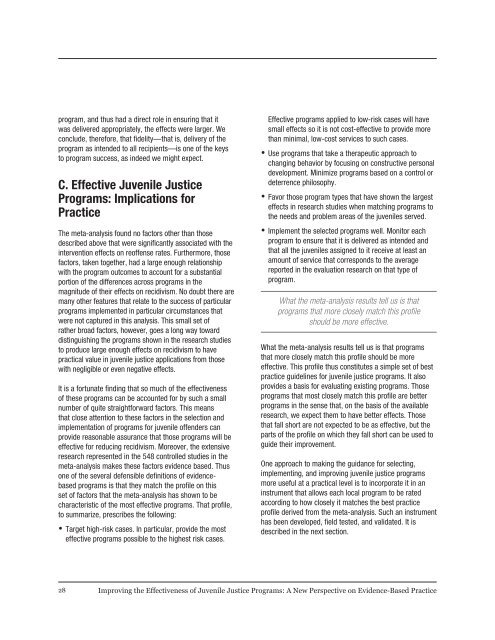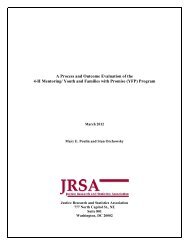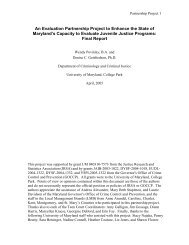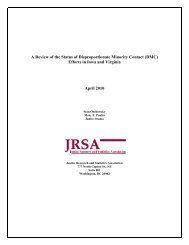Improving the Effectiveness of Juvenile Justice Programs: A New
Improving the Effectiveness of Juvenile Justice Programs: A New
Improving the Effectiveness of Juvenile Justice Programs: A New
You also want an ePaper? Increase the reach of your titles
YUMPU automatically turns print PDFs into web optimized ePapers that Google loves.
program, and thus had a direct role in ensuring that it<br />
was delivered appropriately, <strong>the</strong> effects were larger. We<br />
conclude, <strong>the</strong>refore, that fidelity—that is, delivery <strong>of</strong> <strong>the</strong><br />
program as intended to all recipients—is one <strong>of</strong> <strong>the</strong> keys<br />
to program success, as indeed we might expect.<br />
C. Effective <strong>Juvenile</strong> <strong>Justice</strong><br />
<strong>Programs</strong>: Implications for<br />
Practice<br />
The meta-analysis found no factors o<strong>the</strong>r than those<br />
described above that were significantly associated with <strong>the</strong><br />
intervention effects on re<strong>of</strong>fense rates. Fur<strong>the</strong>rmore, those<br />
factors, taken toge<strong>the</strong>r, had a large enough relationship<br />
with <strong>the</strong> program outcomes to account for a substantial<br />
portion <strong>of</strong> <strong>the</strong> differences across programs in <strong>the</strong><br />
magnitude <strong>of</strong> <strong>the</strong>ir effects on recidivism. No doubt <strong>the</strong>re are<br />
many o<strong>the</strong>r features that relate to <strong>the</strong> success <strong>of</strong> particular<br />
programs implemented in particular circumstances that<br />
were not captured in this analysis. This small set <strong>of</strong><br />
ra<strong>the</strong>r broad factors, however, goes a long way toward<br />
distinguishing <strong>the</strong> programs shown in <strong>the</strong> research studies<br />
to produce large enough effects on recidivism to have<br />
practical value in juvenile justice applications from those<br />
with negligible or even negative effects.<br />
It is a fortunate finding that so much <strong>of</strong> <strong>the</strong> effectiveness<br />
<strong>of</strong> <strong>the</strong>se programs can be accounted for by such a small<br />
number <strong>of</strong> quite straightforward factors. This means<br />
that close attention to <strong>the</strong>se factors in <strong>the</strong> selection and<br />
implementation <strong>of</strong> programs for juvenile <strong>of</strong>fenders can<br />
provide reasonable assurance that those programs will be<br />
effective for reducing recidivism. Moreover, <strong>the</strong> extensive<br />
research represented in <strong>the</strong> 548 controlled studies in <strong>the</strong><br />
meta-analysis makes <strong>the</strong>se factors evidence based. Thus<br />
one <strong>of</strong> <strong>the</strong> several defensible definitions <strong>of</strong> evidencebased<br />
programs is that <strong>the</strong>y match <strong>the</strong> pr<strong>of</strong>ile on this<br />
set <strong>of</strong> factors that <strong>the</strong> meta-analysis has shown to be<br />
characteristic <strong>of</strong> <strong>the</strong> most effective programs. That pr<strong>of</strong>ile,<br />
to summarize, prescribes <strong>the</strong> following:<br />
• Target high-risk cases. In particular, provide <strong>the</strong> most<br />
effective programs possible to <strong>the</strong> highest risk cases.<br />
Effective programs applied to low-risk cases will have<br />
small effects so it is not cost-effective to provide more<br />
than minimal, low-cost services to such cases.<br />
• Use programs that take a <strong>the</strong>rapeutic approach to<br />
changing behavior by focusing on constructive personal<br />
development. Minimize programs based on a control or<br />
deterrence philosophy.<br />
• Favor those program types that have shown <strong>the</strong> largest<br />
effects in research studies when matching programs to<br />
<strong>the</strong> needs and problem areas <strong>of</strong> <strong>the</strong> juveniles served.<br />
• Implement <strong>the</strong> selected programs well. Monitor each<br />
program to ensure that it is delivered as intended and<br />
that all <strong>the</strong> juveniles assigned to it receive at least an<br />
amount <strong>of</strong> service that corresponds to <strong>the</strong> average<br />
reported in <strong>the</strong> evaluation research on that type <strong>of</strong><br />
program.<br />
What <strong>the</strong> meta-analysis results tell us is that<br />
programs that more closely match this pr<strong>of</strong>ile<br />
should be more effective.<br />
What <strong>the</strong> meta-analysis results tell us is that programs<br />
that more closely match this pr<strong>of</strong>ile should be more<br />
effective. This pr<strong>of</strong>ile thus constitutes a simple set <strong>of</strong> best<br />
practice guidelines for juvenile justice programs. It also<br />
provides a basis for evaluating existing programs. Those<br />
programs that most closely match this pr<strong>of</strong>ile are better<br />
programs in <strong>the</strong> sense that, on <strong>the</strong> basis <strong>of</strong> <strong>the</strong> available<br />
research, we expect <strong>the</strong>m to have better effects. Those<br />
that fall short are not expected to be as effective, but <strong>the</strong><br />
parts <strong>of</strong> <strong>the</strong> pr<strong>of</strong>ile on which <strong>the</strong>y fall short can be used to<br />
guide <strong>the</strong>ir improvement.<br />
One approach to making <strong>the</strong> guidance for selecting,<br />
implementing, and improving juvenile justice programs<br />
more useful at a practical level is to incorporate it in an<br />
instrument that allows each local program to be rated<br />
according to how closely it matches <strong>the</strong> best practice<br />
pr<strong>of</strong>ile derived from <strong>the</strong> meta-analysis. Such an instrument<br />
has been developed, field tested, and validated. It is<br />
described in <strong>the</strong> next section.<br />
28 <strong>Improving</strong> <strong>the</strong> <strong>Effectiveness</strong> <strong>of</strong> <strong>Juvenile</strong> <strong>Justice</strong> <strong>Programs</strong>: A <strong>New</strong> Perspective on Evidence-Based Practice

















